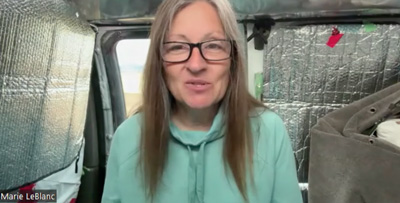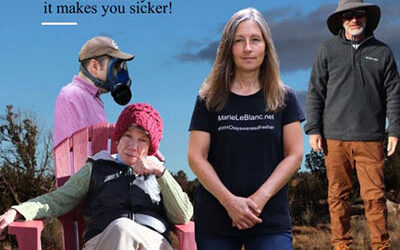by Dorothy Wall
 This essay is the prologue of the book Encounters with the Invisible: Unseen Illness, Controversy, and Chronic Fatigue Syndrome www.dorothywall.com
This essay is the prologue of the book Encounters with the Invisible: Unseen Illness, Controversy, and Chronic Fatigue Syndrome www.dorothywall.com
March 1996
In the evening as we lie in bed, Bill sweeps his palms over the contours of my head and down my spine, along my arms and legs, grazing my skin as if moving over a Ouija board. This has a soothing effect on the muscle pain that clenches my body. He’s got the technique down, a touch so light it’s like a laying on of hands. Moving chi, a friend later tells me. Our improvisation is apparently similar to a technique Chinese healers use to stimulate chi, vital energy. Chi or not, the radiating warmth of his hands seems to pull some of the pulsing ache from my muscles.
This may seem a tender moment, but it’s not. We’re sunk in a boggy, tense confusion. I don’t know what Bill is thinking. It’s dark, and my throat is too sore to talk. His body curved next to mine casts an intimate heat, but I imagine his face has the erased, blank look of someone simply enduring. He strokes my skin because he wants to help, because it’s something he can do. Because I’ve asked him to. He’s burdened, exasperated, trying.
It strikes me that our improvised act goes to the heart of this illness, an expressive mime. Trying things in the dark, in silence, without knowing why. Going on instinct because not much else is offered, no remedy or explanation. Borrowing from Eastern techniques because Western medicine has little to say. And discovering that we can, in our own bumbling way, do something that helps, something rooted in the body, of the body, for the body.
Another scene, this one also in bed, since that’s where I am now, day and night. I’ve discovered a technique for “watching” TV with Bill. We switch off the lights, turn the sound as low as possible. Eyes closed, I listen to a documentary or nature show, the ones with the slow soothing voices that won’t overwhelm my addled brain. A few sentences, a pause, a few more sentences in that serene voice parceled out in pieces I can manage. MTV in reverse. The aural equivalent of large-print books.
Face pressed into my pillow, soles of my feet clamped against Bill’s calf for warmth, I listen one night to a program about Einstein. In the space between sentences I repeat the words in my mind. Without this effort, the words wash over me as unintelligible babble. I strain to make each sentence register, to draw sense out of it, to conjure up its story. I see Einstein in my mind’s eye. His wild, white hair, his silent chalked brilliance on the blackboard, his long-suffering wife—why does she put up with him, the fool—stirring his stew in her own silence.
Einstein lives in my brain, chalk dust flying. Only I can’t make out his revelations. His equations swim unmoored in a vast, black universe. That’s how I imagine them, letters and numbers bloated up large, faded, curved, floating away, uninterpretable and enigmatic. Those essential principles that can explain everything drift away in the dark, disappearing among the gaps and fissures in my head.
An apt image, as it turns out. Many people with CFIDS have what is called focal brain damage, which makes me think of pinholes. MRI (magnetic resonance imaging) brain scans of people with CFIDS often reveal tiny punctate lesions, punctate indicating their pencil-point size, usually in the subcortical white matter. Disconcertingly, these are called UBOs, “unidentified bright objects,” since these points appear on the scan as small white spots, casting those of us with CFIDS into a sci fi dream, which feels fitting.
Like Einstein’s, our brains are lit by constellations of brilliant, unfathomable light. Neuroradiologists argue over what these maps of inner light mean. Have the UBOs of inner space always been there, remaining unseen until new technology brought them, literally, to light? Are they found in healthy adults? Or do they mark a pathology that explains to tens of thousands of people with CFIDS why they find themselves disoriented and confused, putting the garbage in the dishwasher or trying to make a phone call with a calculator?
Brain injury. Viral assault to the brain. These terms, frightening though they are, make sense to me. I am injured, impaired. I stand in the shower with no idea how to make the water cooler, which knob to turn which way. I pour milk into the sink instead of my cereal bowl. If I spot my glasses on the bedside table and reach for them, then seeing my water glass, stop to take a drink, I forget all about the glasses. Distracted by one thought, I can’t keep another in my head.
When they investigated the Incline Village, Nevada, epidemic that occurred in the mid-1980s, Harvard researcher Dr. Anthony Komaroff and his colleagues found brain lesions in twenty-one percent of healthy controls but nearly eighty percent of those who were ill with the mystery disease. These researchers suggested the illness might be a “chronic, immunologically mediated inflammatory process of the central nervous system.” Others in the medical community disputed these interpretations.
We’re all finding our way in the dark.
***
Originally published in Sonora Review, Issue 47, Winter 2004
Copyright © 2004, Dorothy Wall. All rights reserved.
***
Read more about Encounters with the Invisible: Unseen Illness, Controversy, and Chronic Fatigue Syndrome.
Dorothy Wall, M.A., has been active in the Bay Area writing community for over 30 years as a writer, writing teacher and writing consultant. Her recent book, Encounters with the Invisible: Unseen Illness, Controversy, and Chronic Fatigue Syndrome (Southern Methodist University Press, 2005), a collection of essays, blends her experience of ME/CFS with a provocative investigation of the medical/cultural issues raised by an invisible, controversial illness. Winner of a Sand Castle Award from P.A.N.D.O.R.A. for its contribution to ME/CFS advocacy, Encounters with the Invisible will be available in Spanish in 2008. Ms. Wall is particularly interested in the intersection of literature and medicine, and continues to write essays that explore the body, voice and cultural attitudes toward illness.










0 Comments